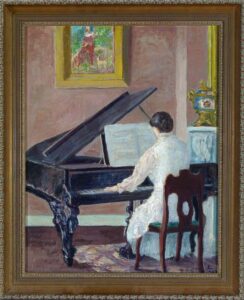Gideon Townsend Stanton
Gideon Townsend Stanton, a stockbroker and artist, was the state director for the Works Progress Administration's Federal Art Project in the 1930s.

Courtesy of New Orleans Auction Galleries
Lady at the Piano. Stanton, Gideon (artist)
Born in Morris, Minnesota, on July 14, 1885, artist Gideon T. Stanton moved to New Orleans around 1888 and lived there until his death on November 23, 1964. Although he worked primarily as a stockbroker, he was active in the city’s art world from 1907 to 1950, achieving prominence as the state director for the Works Progress Administration’s (WPA) Federal Art Project in the 1930s and as an underwriter for New Orleans’ literary journal, The Double Dealer.
Stanton studied with Samuel Edwin Whiteman at the Charcoal Club in Baltimore, Maryland; later, he became known for his oil paintings and pastels. For his subjects, he often chose maritime scenes such as “Floating Prairie of Louisiana” or streetscapes such as “Rainy Night on Canal Street.” He also painted portraits, self-portraits, and landscapes.
Stanton was active in a number of arts organizations. He served as a member of the board of directors of the Art Association of New Orleans from 1919 to 1920, 1924 to 1925, 1928, 1930 to 1932, and as president from 1926 to 1927. He also became a member of the Artists’ Guild in 1921and a charter member of the New Orleans Art League, which he founded with Harry Nolan, in 1927. In addition, he belonged to the Southern States Art League, the Society of Independent Artists, the American Federation of Arts (Washington, D.C.), and the St. Augustine (Florida) Art Association. In New Orleans, he served on the boards of the Delgado Museum of Art and the Arts and Crafts Club of New Orleans.
From 1935 to 1938, Stanton was the Louisiana director for the WPA Federal Art Project. (His successor was Caroline Durieux.) The program was one of four established as part of President Franklin D. Roosevelt’s New Deal to provide work for unemployed artists. All four programs were active in Louisiana. As the largest one, the WPA Federal Art Project employed 3,749 artists nationwide, 65 of whom were from Louisiana.
Stanton’s work was frequently exhibited in New Orleans, primarily in shows sponsored by the Art Association of New Orleans, the Arts and Crafts Club of New Orleans, the New Orleans Art League, and the Artists’ Guild. Outside of Louisiana, his work was put on view in Atlanta, Georgia; Baltimore, Maryland; New York, and Maine. Additional affirmation came from being awarded the Art Association of New Orleans president’s prize in 1925, the New Orleans Art League first prize in oil in 1932, and its second prize in 1947.
Gideon Stanton also led an active social and civic life outside of arts organizations. Papers held in The Historic New Orleans Collection’s Manuscript Division include some of Weeks Hall’s correspondence with him, as well as letters written to him by others staying as guests at Hall’s Shadows on the Teche Plantation in New Iberia, Louisiana. (One letter in the collection, from Louis Oscar Griffith, tells of Robert Grafton’s death.) Evidence of Stanton’s commitment to public works was his involvement with The Double Dealer in the 1920s. When Albert Goodstein, Julius Weiss Friend, John McClure, and Basil Thompson decided to found a journal that would publish the work of emerging writers such as William Faulkner and Ernest Hemingway and thereby refute charges that the South was a literary backwater, Stanton stepped in as a guarantor of their project. His son carried on his commitment by serving as a member of the Advisory Council of the publication’s reincarnation, The Double Dealer Redux.
